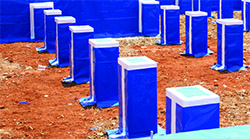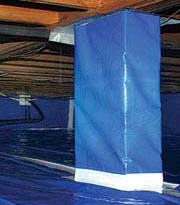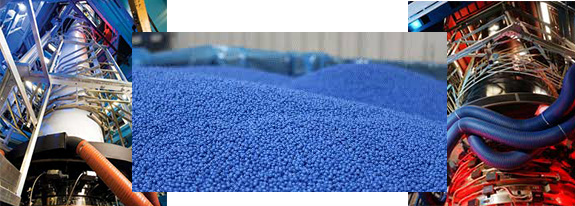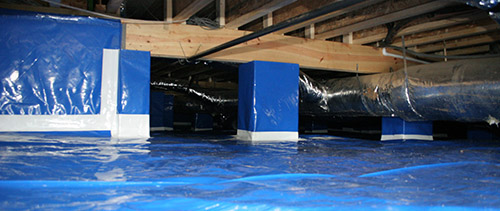Sealing a Crawlspace with VaporFree®
From a psychrometric standpoint, venting a crawlspace to remove moisture only works when the outside air is drier than the crawlspace air. “Drier” does not mean lower relative humidity, but rather a lower absolute humidity. Relative humidity is a ratio of the amount of moisture in the air relative to the amount of moisture the air can hold at a given temperature.
“Absolute humidity is the amount of moisture in an amount of air.”
Air at 85 degrees and 60% RH has the same absolute humidity as air at 70 degrees and 100% RH. So venting 70F/100% RH crawlspace with 85F/60% RH air will not remove moisture, thus moisture moves from wet to dry.
The dew point temperature is the temperature at which condensation forms as the air is cooled. At the dew point temperature, the air is saturated and any further cooling will result in condensation. In the above example, both the 70F/100% RH crawlspace air and the 85F/60% outside air have the same dew point temperature: namely 70F. Venting a crawlspace when the outside air has a higher dew point temperature than the crawlspace air, will actually add moisture to the crawlspace, not remove it.
Percentage of Time Vented Sealed
Above 80% RH 39% 0%
Above 70% RH 79% 0%
Above 60% RH 94% 0%
Above 50% RH 100% 100%
* Supply air @ 20 cfm per 1,000 ft2.
Above 80% RH 39% 0%
Above 70% RH 79% 0%
Above 60% RH 94% 0%
Above 50% RH 100% 100%
* Supply air @ 20 cfm per 1,000 ft2.

A Sealed Crawlspace saves approximately
17% on annual heating and cooling usage and 14% of the total air loss.
VaporFree® Crawlspace vs. Vented Crawlspace:
• VaporFree® Crawlspaces are a better choice because they manage moisture, ensuring that the crawlspace remains drier decreasing the likelihood of mold and decay. In addition wood is stronger when its drier, therefore the structure is better.
• A decrease in moisture in the crawlspace allows air conditioning to run more efficiently as there is less moisture to remove from the air.
• A VaporFree® Crawlspace will reduce total air loss by 14%.

Additional Moisture Management Tips
Initial construction costs associated with building closed crawlspaces will almost always be more than for tradition wall-vented construction. As the new construction methods are evaluated by both builder and researchers, it will be important to factor in 1) the value of reduced callbacks for moisture and mold complaints, 2) the enhanced value along with improved sales price of the structure, and 3) a reduction in legal action. Reduced maintenance, reduction in expensive long-term repairs, and significant energy savings will enhance the value of closed-crawlspace construction to the consumer.Product Description
The VaporFree® System is a high performance vapor retarder made from state of the art polyethylene resins that provide superior performance.A VaporFree ® System offers high tensile strength, unequaled puncture resistance, low moisture vapor permeability as well as resistance to decay. Making VaporFree® one of the industry's top of the line systems!
Please contact Indoor Environmental Services, Inc. if interested in becoming a distributor of VaporFree® Crawlspace Systems.

Product Use
A VaporFree® system can greatly reduce condensation and mold by controlling water vapor migration - protecting the building's interior from the effects of unwanted moisture.-
ADVANTAGES
- high puncture resistance
- high tear resistance
- low permeability
- pin hole free
- economical
- weldable
-
USES
- crawlspace vapor barrier
- crawlspace encapsulation
- under-slab vapor retarder
- excellent roof tarp material
- radon retarder
- ceiling and wall vapor retarder
- divider curtains
- containment walls
- outdoor covers
- lead and asbestos abatement
Size and Packaging
VaporFree® systems are packaged to achieve maximum coverage. For ease of installation and handling all rolls are folded and rolled on heavy-duty cores.The standard size for the 10 mil system is 15' wide by 200' and 12' wide by 200' for the 15 mil system.
Common Applications
• Crawlspaces
• Foundation Wall Vapor Retarder
• Radon Retarder
• Foundation Wall Vapor Retarder
• Radon Retarder
Price / Warranty information
The cost of a VaporFree® system averages considerably less than most competitors. Material is warranted for the life of the structure. Subject to warranty provided.
EPA Research:
36% of air loss is through crawlspace venting.
Standing water is responsible for 90% of building failure.
26 Million existing homes have crawlspaces.
250,000 homes with crawlspaces will be built nationwide in 2007.
36% of air loss is through crawlspace venting.
Standing water is responsible for 90% of building failure.
26 Million existing homes have crawlspaces.
250,000 homes with crawlspaces will be built nationwide in 2007.

